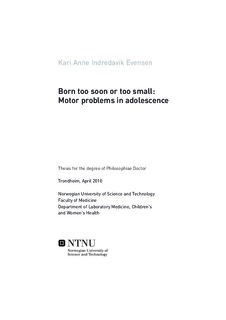| dc.contributor.author | Evensen, Kari Anne Indredavik | nb_NO |
| dc.date.accessioned | 2014-12-19T14:19:33Z | |
| dc.date.available | 2014-12-19T14:19:33Z | |
| dc.date.created | 2011-01-11 | nb_NO |
| dc.date.issued | 2010 | nb_NO |
| dc.identifier | 385758 | nb_NO |
| dc.identifier.isbn | 978-82-471-2057-6 (printed ver.) | nb_NO |
| dc.identifier.isbn | 978-82-471-2058-3 (electronic ver.) | nb_NO |
| dc.identifier.uri | http://hdl.handle.net/11250/263815 | |
| dc.description.abstract | Children born too soon (preterm) and/or too small (small for gestational age suggesting intrauterine growth restriction) have a higher risk of mortality and morbidity than children born at term with appropriate birth weight. Cerebral palsy is the most severe motor sequelae. However, minor motor problems are also frequently reported, particularly in children born preterm. Among children born small for gestational age, motor outcome is less documented and studies have shown inconsistent results.
Few studies have examined motor skills in these children in adolescence. The aim of this study was to assess the prevalence of motor problems in adolescents born preterm with very low birth weight (VLBW) and in adolescents born small for gestational age (SGA) at term. Furthermore, we wanted to study whether visual impairments influenced their motor problems, and whether integration of vision and proprioception was reduced. Finally, we wanted to examine if early motor evaluations could identify children with motor problems in adolescence.
We found that a higher proportion of VLBW and SGA adolescents had motor problems compared with controls, assessed by the Movement Assessment Battery for Children. While both VLBW boys and girls had general motor problems in terms of manual dexterity, ball skills and balance, the motor problems in the SGA group were mainly found among boys in manual dexterity. A substantial part of the motor problems in the VLBW group was influenced by visual impairments; however, this was not the case in the SGA group. The VLBW adolescents performed poorer in a task of inter- and intra-sensory integration compared with controls. However, the unfavourable results were mainly due to adolescents with cerebral palsy or low estimated intelligence quotient. The SGA adolescents performed as well as controls on this task, but had relatively poorer performance with their non-preferred hand compared with their preferred hand. Most of the VLBW adolescents with motor problems were identified already at one year, using the motor scale of the Bayley Scales of Infant Development. However, this test did not identify SGA children who had motor problems at age 14, whereas half of them were identified at five years of age using the Peabody Developmental Motor Scales.
The results of this study suggest that motor problems in the VLBW group are due to a general brain damage following preterm birth, whereas motor problems in the SGA group may be caused by subtle brain dysfunctions following intrauterine growth restriction. | nb_NO |
| dc.language | eng | nb_NO |
| dc.publisher | Norges teknisk-naturvitenskapelige universitet, Det medisinske fakultet, Institutt for laboratoriemedisin, barne- og kvinnesykdommer | nb_NO |
| dc.relation.ispartofseries | Doktoravhandlinger ved NTNU, 1503-8181; 2010:51 | nb_NO |
| dc.relation.ispartofseries | Dissertations at the Faculty of Medicine, 0805-7680; 432 | nb_NO |
| dc.relation.haspart | Evensen, K A I; Vik, T; Helbostad, J; Indredavik, M S; Kulseng, S; Brubakk, A-M. Motor skills in adolescents with low birth weight.. Archives of Disease in Childhood - Fetal and Neonatal Edition. (ISSN 1359-2998). 89(5): F451-5, 2004. <a href='http://dx.doi.org/10.1136/adc.2003.037788'>10.1136/adc.2003.037788</a>. <a href='http://www.ncbi.nlm.nih.gov/pubmed/15321969'>15321969</a>. | nb_NO |
| dc.relation.haspart | Evensen, Kari Anne I; Lindqvist, Susanne; Indredavik, Marit S; Skranes, Jon; Brubakk, Ann-Mari; Vik, Torstein. Do visual impairments affect risk of motor problems in preterm and term low birth weight adolescents?. European journal of paediatric neurology. (ISSN 1090-3798). 13(1): 47-56, 2009. <a href='http://dx.doi.org/10.1016/j.ejpn.2008.02.009'>10.1016/j.ejpn.2008.02.009</a>. <a href='http://www.ncbi.nlm.nih.gov/pubmed/18430596'>18430596</a>. | nb_NO |
| dc.relation.haspart | Evensen, Kari Anne Indredavik; Sigmundsson, Hermundur; Romundstad, Pål; Indredavik, Marit S; Brubakk, Ann-Mari; Vik, Torstein. Inter- and intra-modal matching in very low birth weight and small for gestational age adolescents.. Early Human Development. (ISSN 0378-3782). 83(1): 19-27, 2007. <a href='http://dx.doi.org/10.1016/j.earlhumdev.2006.03.015'>10.1016/j.earlhumdev.2006.03.015</a>. <a href='http://www.ncbi.nlm.nih.gov/pubmed/16750603'>16750603</a>. | nb_NO |
| dc.relation.haspart | Evensen, Kari Anne I; Skranes, Jon; Brubakk, Ann-Mari; Vik, Torstein. Predictive value of early motor evaluation in preterm very low birth weight and term small for gestational age children.. Early Human Development. (ISSN 0378-3782). 85(8): 511-8, 2009. <a href='http://dx.doi.org/10.1016/j.earlhumdev.2009.04.007'>10.1016/j.earlhumdev.2009.04.007</a>. <a href='http://www.ncbi.nlm.nih.gov/pubmed/19450939'>19450939</a>. | nb_NO |
| dc.title | Born too soon or too small:Motor problems in adolescence | nb_NO |
| dc.type | Doctoral thesis | nb_NO |
| dc.contributor.department | Norges teknisk-naturvitenskapelige universitet, Det medisinske fakultet, Institutt for laboratoriemedisin, barne- og kvinnesykdommer | nb_NO |
| dc.description.degree | PhD i klinisk medisin | nb_NO |

